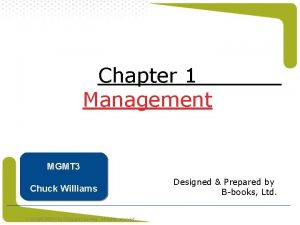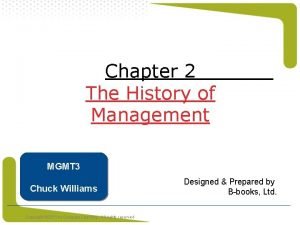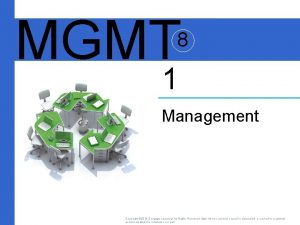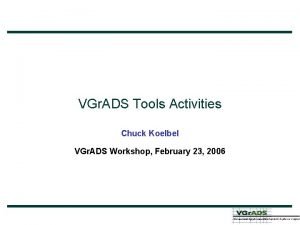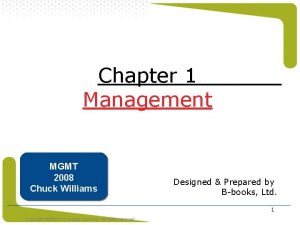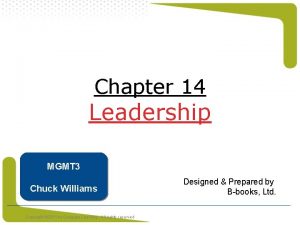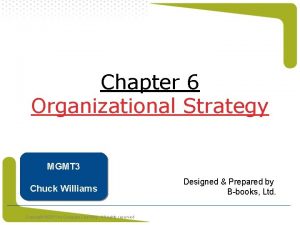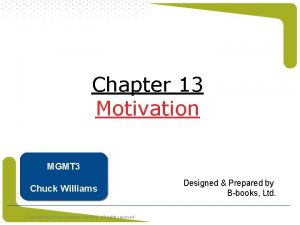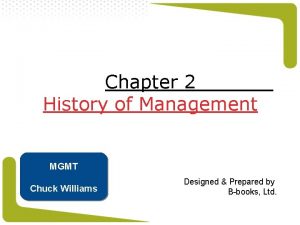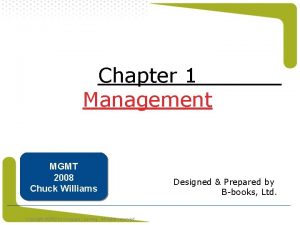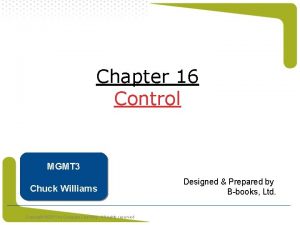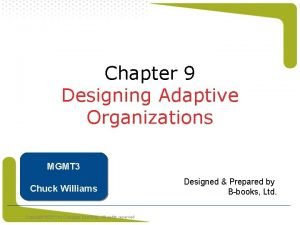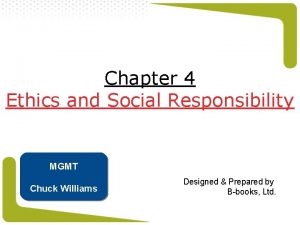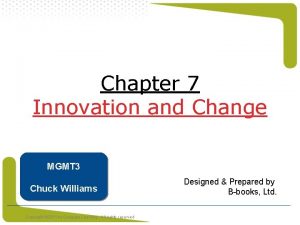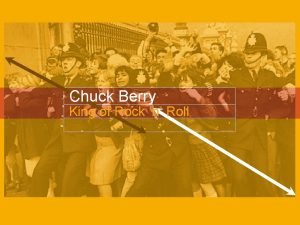Chapter 14 Leadership MGMT Chuck Williams Designed Prepared


































- Slides: 34

Chapter 14 Leadership MGMT Chuck Williams Designed & Prepared by B-books, Ltd. 1

What Is Leadership? After reading these sections, you should be able to: 1. explain what leadership is. 2. describe who leaders are and what effective leaders do. 2

Leadership Differences between Leaders and Managers 1 3

Leaders versus Managers MANAGERS LEADERS Do things right Status quo Short-term Means Builders Problem solving Do the right thing Change Long-term Ends Architects Inspiring & motivating 1 4

Leaders versus Managers American organizations (and probably those in much of the rest of the industrialized world) are under led and over managed. They do not pay enough attention to doing the right thing, while they pay too much attention to doing things right. - Warren Bennis 1 5

Who Leaders Are and What Leaders Do Leadership Traits Leadership Behavior 2 6

Leadership Traits Leaders differ from non-leaders: Drive Strong desire to lead Honesty Integrity Self-confidence Emotional stability Cognitive Ability 2 Knowledge of Business 7

Leadership Behaviors Initiating Structure The degree to which a leader structures the roles of followers by setting goals, giving directions, setting deadlines, and assigning tasks. Consideration The extent to which a leader is friendly, approachable, and supportive and shows concern for employees. 2. 2 8

Blake/Moulton Leadership Grid High 9 1, 9 Concern for People 8 Team 9, 9 Management 7 6 Middle of the 5, 5 Road 5, 5 5 4 3 2 Low 1 2. 2 Country Club Management Impoverished 1, 1 Management 1 Low 2 3 4 Authority. Compliance 9, 1 5 6 7 Concern for Production 8 9 High 9

Situational Approaches to Leadership After reading these sections, you should be able to: 3. explain Fiedler’s contingency theory. 4. describe how path-goal theory works. 5. explain the normative decision theory. 10

Putting Leaders in the Right Situation: Fiedler’s Contingency Theory Situational Favorableness Group Performance = Leadership Style 3 11

Putting Leaders in the Right Situation: Fiedler’s Contingency Theory Workgroups They Lead Perform Well Matching Leadership Styles to Situations Degree to Which the Situation Permits the Leader to Influence Behavior of Group Members 3 12

Leadership Style: Least Preferred Coworker • Leadership style is the way a leader generally behaves toward followers – seen as stable and difficult to change • Style is measured by the Least Preferred Co-worker scale (LPC) – relationship-oriented – task-oriented 3. 1 13

Leadership Style: Least Preferred Coworker Scale 3. 1 14

Situational Favorableness The degree to which a particular situation either permits or denies a leader the chance to influence the behavior of group members. Three factors: § Leader-member relations § Task structure § Position power 3. 2 15

Situational Favorableness 3. 2 16

Matching Leadership Styles to Situations 3. 3 17

Path-Goal Theory A leadership theory that states that leaders can increase subordinate satisfaction and performance by clarifying and clearing the paths to goals and by increasing the number and kinds of rewards available for goal attainment. 4 18

Basic Assumptions of Path-Goal Theory Clarify paths to goals Clear paths to goals by solving problems and removing roadblocks Increase the number and kinds of rewards available for goal attainment Do things that satisfy followers today or will lead to future rewards or satisfaction 4 Offer followers something unique and valuable beyond what they’re experiencing 19

Adapting Leader Behavior: Path-Goal Theory Leadership Styles Subordinate and Environmental Contingencies Outcomes 4 20

Leadership Styles • Directive – clarifying expectations and guidelines • Supportive – being friendly and approachable • Participative – allowing input on decisions 4. 1 • Achievement-Oriented – setting challenging goals 21

Subordinate and Environmental Contingencies Subordinate Environmental ü Perceived ability ü Task structure ü Locus of control ü Formal authority system ü Experience ü Primary work group 4. 2 22

Path Goal Theory: When to Use Leadership Styles 4. 2 23

Normative Decision Theory Decision Styles Decision Quality and Acceptance 5 24

Decision Styles Leader accepts any decision supported by the entire group Leader solves the problem or makes the decision AI Solve the problem yourself AII Obtain information. Select a solution yourself. CI CII GII Share problem, get ideas from individuals. Select a solution yourself. Share problem with group, get ideas. Make decision, which may or may not reflect input. Share problem with group. Together try to reach a solution. Leader acts as facilitator. 5. 1 25

Decision Quality and Acceptance • Using the right amount of employee participation: – improves decision quality – improves acceptance • Decision tree helps leader identify optimal level of participation 5. 2 26

Strategic Leadership After reading this section, you should be able to: 6. explain how visionary leadership (i. e. , charismatic and transformational leadership) helps leaders achieve strategic leadership. 27

Visionary Leadership Charismatic Leadership Transformational Leadership 6 28

Charismatic Leadership • Creates an exceptionally strong relationship between leader and follower • Charismatic leaders: – articulate a clear vision based on values – model values consistent with vision – communicate high performance expectations – display confidence in followers’ abilities 6. 1 29

Kinds of Charismatic Leaders • Ethical Charismatics – – – provide developmental opportunities are open to positive and negative feedback recognize others’ contributions share information show concern for the interests of the group • Unethical Charismatics 6. 1 – – control and manipulate followers do what is best for themselves only want positive feedback motivated by self-interest 30

Ethical and Unethical Charismatic Leaders Charismatic Leader Behaviors Ethical Charismatics Exercising Power Use power to serve others Creating the vision Ask followers to help develop the vision Communicating with followers Engage in two-way communication Accepting feedback Are open to feedback Stimulating followers Want followers to think and to question the status quo Developing followers Focus on developing followers Living by moral standards Exhibit three virtues: courage, sense of fairness, integrity 6. 1 31

Ethical and Unethical Charismatic Leaders Charismatic Leader Behaviors Unethical Charismatics Exercising Power Use power to dominate others Creating the vision Sole provider of vision Communicating with followers Engage in one-way communication, not open to input from others Accepting feedback Prefer yes-men, punish candid feedback Stimulating followers Don’t want followers to think, prefer uncritical acceptance of own ideas Developing followers Insensitive to followers’ needs Living by moral standards Follow standards only if they satisfy immediate self interests 6. 1 32

Transformational Leadership • Generates awareness and acceptance of group’s purpose and mission • Gets followers to accomplish more than they intended or thought possible 6. 2 33

Components of Transformational Leadership 1. 2. 3. 4. Charisma or idealized influence Inspirational motivation Intellectual stimulation Individualized consideration 6. 2 34
 Management by chuck williams
Management by chuck williams Verna and sam barriers
Verna and sam barriers Andy williams robert williams
Andy williams robert williams Robbie williams janet williams
Robbie williams janet williams Infrastructure mgmt
Infrastructure mgmt Professional portfolio management tim washington
Professional portfolio management tim washington Mgmt 11 principles of management
Mgmt 11 principles of management Mgmt 4
Mgmt 4 Mgmt 371
Mgmt 371 2016 cengage learning
2016 cengage learning Mgmt 371
Mgmt 371 Keller graduate school of mgmt
Keller graduate school of mgmt Mgmt 341
Mgmt 341 Mgmt 371 final exam
Mgmt 371 final exam Mgmt 650 quiz 4
Mgmt 650 quiz 4 Locational break even analysis
Locational break even analysis Mgmt ama
Mgmt ama Mgmt ama
Mgmt ama Mgmt 411 purdue
Mgmt 411 purdue Transformational vs transformative leadership
Transformational vs transformative leadership Adaptive leadership characteristics
Adaptive leadership characteristics Enthusiastic beginner disillusioned learner
Enthusiastic beginner disillusioned learner Duane hanson tourists 1970
Duane hanson tourists 1970 3-jaw chuck grasp
3-jaw chuck grasp Bernoulli chuck
Bernoulli chuck Pitot tube bernoulli equation
Pitot tube bernoulli equation Physics workshop skills pdf
Physics workshop skills pdf Chuck noland character analysis
Chuck noland character analysis Chuck baird famous paintings
Chuck baird famous paintings Chuck tolbert
Chuck tolbert Network chuck kasm
Network chuck kasm Chuck cusack
Chuck cusack Drill press tray
Drill press tray Chuck sox membuat kotak kayu
Chuck sox membuat kotak kayu Lucas by chuck close
Lucas by chuck close
